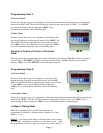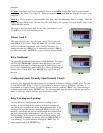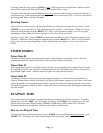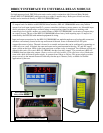
Page
15
Audio Alarm On/Off:
This unit supports an audio alarm option which comes on when ever
a limit value is exceeded. This alarm can be turned On or Off, as
desired. The selection is made by pushing ‘^DIGv’ key. If the alarm
is ON, the display will read ‘ALR ON’ (Alarm On). Alternately, it
will display ‘ALR OFF’ (for ‘Alarm Off’). Push ‘SETUP’ key after
desired setting is displayed. This last push on SETUP key will also
take you back to the very beginning of setup mode.
To get out of SETUP mode at this point (or at any time during setup),
simply push and hold RESET key. The display will read ‘SAVInG’
and then exit setup.
RATE
DPS3301 monitors rate of change of temperature per programmed time base and can be displayed by
pushing the ‘DATA’ key (time base is programmed during SETUP procedure). The unit is capable of
displaying instantaneous (calculated over the last time base period) as well as average rate of temperature
change. Push DATA key sequentially till the display reads ‘In rAtE’. On releasing the DATA key at this
point will display instantaneous rate. One more push on DATA key will bring up the unit in Average rate
display mode. The unit will display Average rate value preceeded by the message ‘AG RATE’. Averaging
of the rate can be reset by resetting ‘Elapsed Time’ (push ‘TIME’ and ‘RESET’ keys simultaneously to
reset TIME).
Rate Alarm:
Limit 3 has the capability to work either as process alarm or as rate alarm. This configuration is done during
setup (look under SETUP). Also entered during setup is the alarm value. Programmed rate alarm value is
absolute and it works on negative as well as positive rates e.g. if rate alarm value is 10, then alarm output
will get activated if rate exceeds –10 or +10. It should be noted that rate alarm is based on
instantaneous
rate calculated over last time period (look under SETUP to program time period).
Resetting Rate Alarm:
Once energized, rate alarm can be reset in two different ways --- automatically or manually (non latching or
latching). In non latching mode the alarm output will de-energize automatically when rate drops below rate
limit value. In latching mode, the output has to be reset manually. For manual reset, first make the display
indicate ‘rAtE Lt’ (for ‘Rate Limit’) by pushing the ‘DATA’ key successively (also look under ‘Process
Alarms’). Next,
while keeping the ‘DATA’ key pushed, go on to push the ‘RESET’ key. Rate alarm will
de-energize and the display will indicate so by displaying RLY RST. Selection of latching or non-latching
mode for outputs is done during setup.
SETPOINT DEVIATION ALARM:
Setpoint deviation is the differential between actual process reading
and current setpoint. This feature is useful for monitoring how well
the process is keeping up with the ramping setpoint. To display
deviation, push ‘SP DEV’ key once. The display will read ‘SP
DEVN’ following which the current deviation of process from the


















